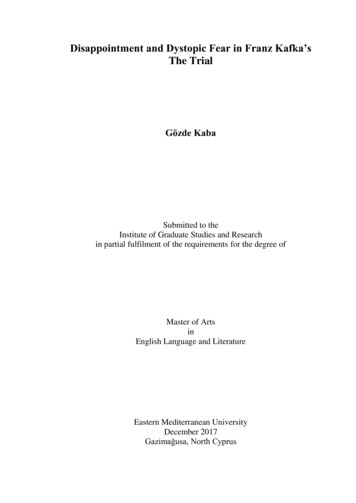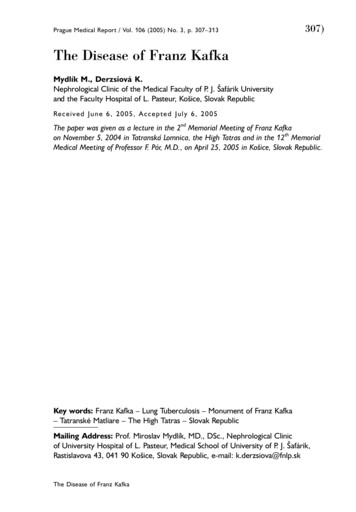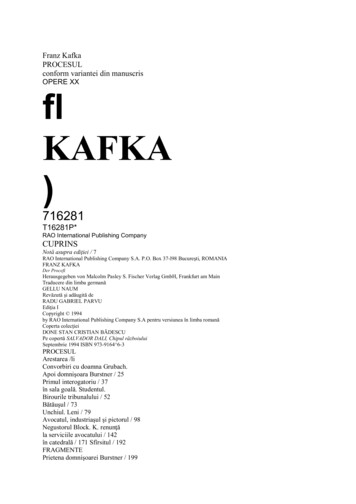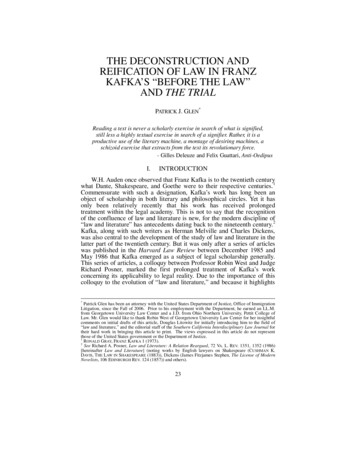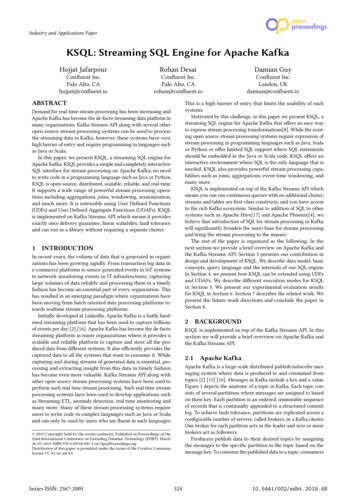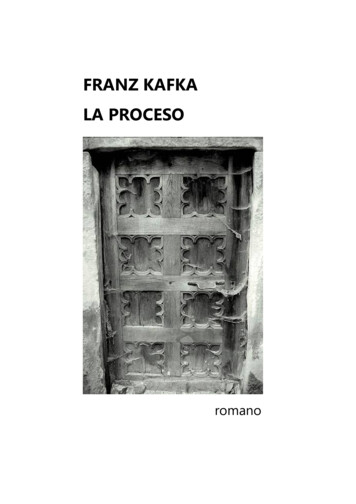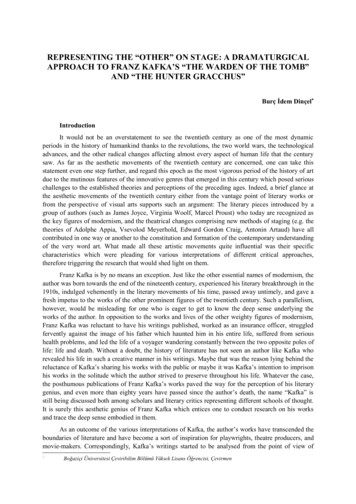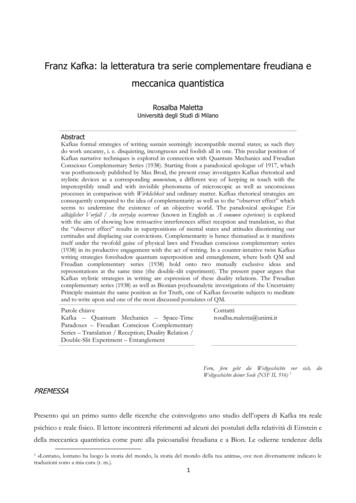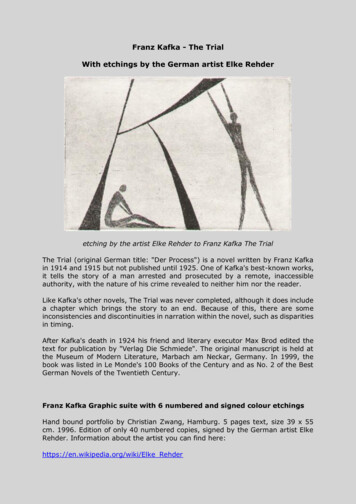
Transcription
Franz Kafka - The TrialWith etchings by the German artist Elke Rehderetching by the artist Elke Rehder to Franz Kafka The TrialThe Trial (original German title: "Der Process") is a novel written by Franz Kafkain 1914 and 1915 but not published until 1925. One of Kafka's best-known works,it tells the story of a man arrested and prosecuted by a remote, inaccessibleauthority, with the nature of his crime revealed to neither him nor the reader.Like Kafka's other novels, The Trial was never completed, although it does includea chapter which brings the story to an end. Because of this, there are someinconsistencies and discontinuities in narration within the novel, such as disparitiesin timing.After Kafka's death in 1924 his friend and literary executor Max Brod edited thetext for publication by "Verlag Die Schmiede". The original manuscript is held atthe Museum of Modern Literature, Marbach am Neckar, Germany. In 1999, thebook was listed in Le Monde's 100 Books of the Century and as No. 2 of the BestGerman Novels of the Twentieth Century.Franz Kafka Graphic suite with 6 numbered and signed colour etchingsHand bound portfolio by Christian Zwang, Hamburg. 5 pages text, size 39 x 55cm. 1996. Edition of only 40 numbered copies, signed by the German artist ElkeRehder. Information about the artist you can find here:https://en.wikipedia.org/wiki/Elke Rehder
Franz Kafka - The Trial - faces over the town
Franz Kafka - The Trial - the court floor
Franz Kafka - The Trial - whipper
Franz Kafka - The Trial - K. at the desk
Franz Kafka The Trial - before the law with the doorkeeper appearing at thecathedral
Franz Kafka - The Trial - The end in the quarry on a stone
Franz Kafka The Trial - Portfolio with 6 etchings
Variations and other etchings to The TrialFranz Kafka The Trial - Faces IArtist's proof, image size 20 x 30 cm on sheet size 22 x 31 cm.Article number P15-1a
Franz Kafka The Trial - Faces IIArtist's proof, image size 20 x 30 cm on sheet size 22 x 31 cm.Article number P15-1b
Franz Kafka The Trial - Court Floor II, 2014Edition of 35. Image size 20 x 30 cm on sheet size 38 x 54 cm.Article number P15-2B
Franz Kafka The Trial - Court Floor IIIEdition of 35. Image size 20 x 30 cm on sheet size 38 x 54 cm.Article number P15-2F
Franz Kafka The Trial - Whipper IArtist's proof, image size 20 x 30 cm on sheet size 22 x 31 cm.Article number P15-3a
Franz Kafka The Trial - Whipper II, 2014Edition of 35. Image size 20 x 30 cm on sheet size 38 x 54 cm.Article number P15-3B
Franz Kafka The Trial - Whipper IIIEdition of 35. Image size 20 x 30 cm on sheet size 38 x 54 cm.Article number P15-3F
Franz Kafka The Trial - K. sitting at a deskEdition of 35. Image size 20 x 30 cm on sheet size 38 x 54 cm.Article number P15-4F
Franz Kafka The Trial - K. sitting at a desk.Unique paper art object with etching.Image size 20 x 30 cm on sheet size 38 x 54 cm.Article number P15-4P
Franz Kafka The Trial - doorkeeper IArtist's proof, Image size 20 x 30 cm on sheet size 22 x 31 cm.Article number P15-5a
Franz Kafka The Trial - doorkeeper II, 2014Edition of 35. Image size 20 x 30 cm on sheet size 38 x 54 cm.Article number P15-5B
Franz Kafka - WhipperPen and ink drawing with watercolor. Size 22 x 17 cm. 2006.Article number ZFK03
Franz Kafka - Three positions in front of a windowPen and ink drawing with watercolor. Size 22 x 17 cm. 2006.Article number ZFK04
Franz Kafka - Court FloorCharcoal drawing. Size 21 x 30 cm. 2002.Article number ZFK05Plot summaryOn his thirtieth birthday, the chief financial officer of a bank, Josef K., isunexpectedly arrested by two unidentified agents from an unspecified agency foran unspecified crime. The agents' boss later arrives and holds a mini-tribunal inthe room of K.'s neighbor, Fräulein Bürstner. K. is not taken away, however, butleft "free" and told to await instructions from the Committee of Affairs. He goes towork, and that night apologizes to Fräulein Bürstner for the intrusion into her room.At the end of the conversation he suddenly kisses her.K. receives a phone call summoning him to court, and the coming Sunday isarranged as the date. No time is set, but the address is given to him. The addressturns out to be a huge tenement building. K. has to explore to find the court, whichturns out to be in the attic. The room is airless, shabby, and crowded, and althoughhe has no idea what he is charged with, or what authorizes the process, K. makesa long speech denigrating the whole process, including the agents who arrestedhim; during this speech an attendant's wife and a man engage in sexual activities.K. then returns home.
K. later goes to visit the court again, although he has not been summoned, andfinds that it is not in session. He instead talks with the attendant's wife, whoattempts to seduce him into taking her away, and who gives him more informationabout the process and offers to help him. K. later goes with the attendant to ahigher level of the attic where the shabby and airless offices of the court arehoused.K. returns home to find Fräulein Montag, a lodger from another room, moving inwith Fräulein Bürstner. He suspects that this is to prevent him from pursuing hisaffair with the latter woman. Yet another lodger, Captain Lanz, appears to be inleague with Montag.Later, in a store room at his own bank, K. discovers the two agents who arrestedhim being whipped by a flogger for asking K. for bribes and as a result ofcomplaints K. made at court. K. tries to argue with the flogger, saying that themen need not be whipped, but the flogger cannot be swayed. The next day hereturns to the store room and is shocked to find everything as he had found it theday before, including the Whipper and the two agents.K. is visited by his uncle, who was K.'s guardian. The uncle seems distressed byK.'s predicament. At first sympathetic, he becomes concerned that K. isunderestimating the seriousness of the case. The uncle introduces K. to a lawyer,who is attended by Leni, a nurse, who K.'s uncle suspects is the advocate'smistress. During the discussion it becomes clear how different this process is fromregular legal proceedings: guilt is assumed, the bureaucracy running it is vast withmany levels, and everything is secret, from the charge, to the rules of the court,to the authority behind the courts – even the identity of the judges at the higherlevels. The attorney tells him that he can prepare a brief for K., but since thecharge is unknown and the rules are unknown, it is difficult work. It also nevermay be read, but is still very important. The lawyer says that his most importanttask is to deal with powerful court officials behind the scenes. As they talk, thelawyer reveals that the Chief Clerk of the Court has been sitting hidden in thedarkness of a corner. The Chief Clerk emerges to join the conversation, but K. iscalled away by Leni, who takes him to the next room, where she offers to help himand seduces him. They have a sexual encounter. Afterwards K. meets his uncleoutside, who is angry, claiming that K.'s lack of respect has hurt K.'s case.K. visits the lawyer several times. The lawyer tells him incessantly how dire hissituation is and tells many stories of other hopeless clients and of his behind-thescenes efforts on behalf of these clients, and brags about his many connections.The brief is never complete. K.'s work at the bank deteriorates as he is consumedwith worry about his case.K. is surprised by one of his bank clients, who tells K. that he is aware that K. isdealing with a trial. The client learned of K.'s case from Titorelli, a painter, whohas dealings with the court and told the client about K.'s case. The client advisesK. to go to Titorelli for advice. Titorelli lives in the attic of a tenement in a suburbon the opposite side of town from the court that K. visited. Three teenage girlstaunt K. on the steps and tease him sexually. Titorelli turns out to be an officialpainter of portraits for the court – an inherited position – and has a deepunderstanding of the process. K. learns that, to Titorelli's knowledge, not a singledefendant has ever been acquitted. He sets out K.'s options and offers to help K.with either. The options are: obtain a provisional verdict of innocence from the
lower court, which can be overturned at any time by higher levels of the court,which would lead to re-initiation of the process; or curry favor with the lowerjudges to keep the process moving at a glacial pace. Titorelli has K. leave througha small back door, as the girls are blocking the door through which K. entered. ToK.'s shock, the door opens into another warren of the court's offices – again shabbyand airless.K. decides to take control of matters himself and visits his lawyer with the intentionof dismissing him. At the lawyer's office he meets a downtrodden individual, Block,a client who offers K. some insight from a client's perspective. Block's case hascontinued for five years and he has gone from being a successful businessman tobeing almost bankrupt and is virtually enslaved by his dependence on the lawyerand Leni, with whom he appears to be sexually involved. The lawyer mocks Blockin front of K. for his dog-like subservience. This experience further poisons K.'sopinion of his lawyer. (This chapter was left unfinished by the author.)K. is asked by the bank to show an Italian client around local places of culturalinterest, but the Italian client, short of time, asks K. to take him only to thecathedral, setting a time to meet there. When the client does not show up, K.explores the cathedral, which is empty except for an old woman and a churchofficial. K. notices a priest who seems to be preparing to give a sermon from asmall second pulpit, and K. begins to leave, lest it begin and K. be compelled tostay for its entirety. Instead of giving a sermon, the priest calls out K.'s name. K.approaches the pulpit and the priest berates him for his attitude toward the trialand for seeking help, especially from women. K. asks him to come down and thetwo men walk inside the cathedral. The priest works for the court as a chaplainand tells K. a fable (which was published earlier as "Before the Law") that is meantto explain his situation. K. and the priest discuss the parable. The priest tells K.that the parable is an ancient text of the court, and many generations of courtofficials have interpreted it differently.On the eve of K.'s thirty-first birthday, two men arrive at his apartment. He hasbeen waiting for them, and he offers little resistance – indeed the two men takedirection from K. as they walk through town. K. leads them to a quarry where thetwo men place K's head on a discarded block. One of the men produces a doubleedged butcher knife, and as the two men pass it back and forth between them,the narrator tells us that "K. knew then precisely, that it would have been his dutyto take the knife.and thrust it into himself." He does not take the knife. One ofthe men holds his shoulder and pulls him up and the other man stabs him in theheart and twists the knife twice. K.'s last words are: "Like a dog!" (Text taken fromthe Wikipedia Encyclopedia)More information at my German st/franz-kafka-process.htm
Franz Kafka - The Trial With etchings by the German artist Elke Rehder etching by the artist Elke Rehder to Franz Kafka The Trial The Trial (original German title: "Der Process") is a novel written by Franz Kafka in 1914 and 1915 but not published until 1925. One of Kafka's best-known works,

